

... Alan Miller
By Al Backiel
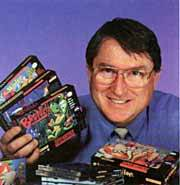
DP: Was Atari your first employer after graduating college?
Alan Miller: No, I graduated from the University of California at Berkeley in June 1973 with a Bachelors degree in Electrical Engineering and Computer Science. I started working at Atari about four years later, in February 1977. In the first four years after graduating, I worked in various electrical engineering jobs in Silicon Valley, first for an industrial control company, and then on NASA projects, and just prior to Atari, for a semiconductor manufacturer.
DP: What was the best source for game ideas? Marketing, arcades, meetings, users, or programmers?
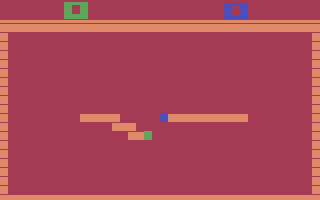 Alan Miller:
For me, it was none of those. My first game for the Atari VCS,
Surround, was assigned to me. After that, the best source of game ideas for
me was thinking them up myself. In the early days, the extreme hardware
constraints eliminated most obvious game designs. So, game concepts had to be
developed with those constraints expressly in mind. After I came up with a
concept that I thought would be fun and could be implemented, I wrote it up and
discussed it with others in the group, like David Crane, Bob Whitehead, and
Larry Kaplan. Few of my game ideas were abandoned. Of course, we also played
all the arcade games as well as the home game carts that were already available
from Fairchild and RCA. All of these, Iím sure, had an influence on us.
Alan Miller:
For me, it was none of those. My first game for the Atari VCS,
Surround, was assigned to me. After that, the best source of game ideas for
me was thinking them up myself. In the early days, the extreme hardware
constraints eliminated most obvious game designs. So, game concepts had to be
developed with those constraints expressly in mind. After I came up with a
concept that I thought would be fun and could be implemented, I wrote it up and
discussed it with others in the group, like David Crane, Bob Whitehead, and
Larry Kaplan. Few of my game ideas were abandoned. Of course, we also played
all the arcade games as well as the home game carts that were already available
from Fairchild and RCA. All of these, Iím sure, had an influence on us.
I had some previous experience thinking up interactive entertainment, but not for video games. As the eldest of six kids, I felt a lot of responsibility to help take care of my five younger brothers and sisters. I enjoyed coming up with new games and activities to entertain them and keep them occupied. I also played a lot of board and card games and participated in a lot of sports as a kid and played on my high schoolís basketball and baseball teams.
DP: From what we know, the game Surround started out as Blockade. Were there any other name changes in any other games that you can recall?
Alan Miller:
Surround was never called Blockade. Surround was based on a game play
concept implemented in several arcade games in the mid-70s, such as Atariís
Dominos, Gremlinís Blockade, and Meadowís Bigfoot. I donít remember
its working title. I donít think it had a marketing title othe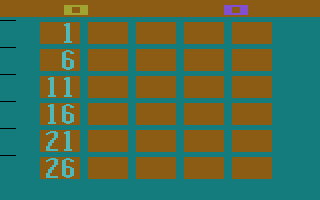 r than Surround.
If it did, it wouldnít have been the name of a competitorís game.
r than Surround.
If it did, it wouldnít have been the name of a competitorís game.
The title of an Atari VCS game I programmed called Hunt & Score was also later marketed by Atari under the title A Game of Concentration. In the early days of the VCS, Atari frequently changed the cart titles for games marketed under the Sears Tele-Games brand. Hunt & Score was called Memory Match for Sears
DP: You stated that Surround was never Blockade. I actually got that bit of information from a list of the first nine Atari 2600 releases that appeared onscreen in the ďStella At 20Ē documentary. Perhaps this was not an official list? It was hand-written. Or was this just someoneís personal notes
Alan Miller: I havenít seen the Stella At 20 tape and canít yet comment on what was shown. Iíll try to find a copy. I doubt that there was ever any meaningful list like you describe. I started working at Atari on February 22, 1977 and was assigned which game Iíd do for my first game. So I began working on Surround in late February or early March 1977. Surround was introduced about 14 weeks later at the June 1977 CES in Chicago. I did not personally attend that show.
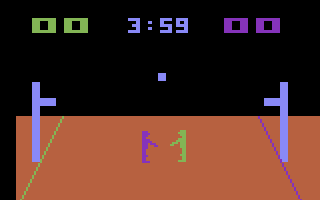
I donít think nine different games were under development in the Feb-June timeframe, but I suppose itís possible. The only game programmers in Atariís Consumer Group at that time were Larry Wagner and Larry Kaplan, who joined in late 1976, Bob Whitehead, who started in January 1977, and Gary Palmer and I, who started in Feb 1977.
Joe Decuir, who was more of a systems/chip designer, did the Pong (Video Olympics) cart. Larry Wagner started the Combat cart, and Larry Kaplan helped finish it after he completed Air-Sea Battle. Bob did Star Ship and then Blackjack. As I recall, Gary did quite a bit of development system design before he started a cart (Basic Math). When we arrived at Atari, their game development process was not very sophisticated. Larry and I had worked on DEC PDP-11 systems before joining Atari and we convinced the company to start using these minicomputers. Atari had been using the very simple KIM boards for code debugging. Gary designed a pretty good debugging station.
So, to the best of my knowledge, Surround was never called Blockade. Atariís own arcade version of this type of game was called Dominos. Gremlinís version was called Blockade. I really doubt Atariís marketing people would have started out naming it with the name of a competitorís product.

Larry Wagner's notes regarding the original 9 VCS carts under development, dated 5-17-77
DP: Were there routines or features in your games that had to be scrapped because they would have exceeded storage?
Alan Miller:
Yes, that happened all the time. Most early VCS ROM carts were only 2K
bytes. Programmers had to put tremendous effort into implementing a decent game
in that small space. I
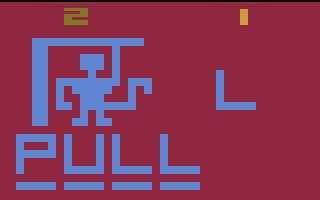 remember that among many other features I had to kill, I
was always frustrated by not being able to develop enough ROM space to computer
opponent AI in my games. Additionally, there were only 128 bytes of RAM in the
VCS, which also tremendously limited what could be done.
remember that among many other features I had to kill, I
was always frustrated by not being able to develop enough ROM space to computer
opponent AI in my games. Additionally, there were only 128 bytes of RAM in the
VCS, which also tremendously limited what could be done.
My game, Hangman, was the first 4K byte cart for the VCS, but the extra space in that cart was simply used to store additional words. Being the first one to use that part, I had to electronically qualify it with the ROM vendor, Synertec, to make sure it met the timing and current requirements of the VCS.
Bank-switching circuits were eventually developed for the VCS that allowed programs to be larger than 4K bytes. Also at Activision, the Display Processor Chip (DPC, named after its creator, David Patrick Crane) was created, which added additional power to the VCS. Unfortunately, that was near the end of the VCSí lifecycle and I think only one game, Pitfall II, was developed with it.
To put that into perspective, a modern single CD game is 650 megabytes, which is 325,000 times larger than our first VCS game carts. Modern computers probably average 128 megabytes of RAM, which is 1,000,000 times more RAM than the Atari VCS had. A modern game requires several man years of development effort and averages about $5 million in development cost. At Atari, development of a VCS cart took about 0.3-0.5 man years at a total cost of about $8,000-$15,000.
DP: You were a contributor to the operating systems of some Atari computers. Do you prefer systems programming or applications programming?
Alan Miller: I strongly prefer applications programming. I like seeing tangible results of my work. OS programming is obviously necessary, but I didnít find it particularly rewarding. But Iím very proud of the OS we created for the Atari 400/800. It was similar in complexity to QDOS Ė the OS that Microsoft licensed a couple of years later from Seattle Computer Products and renamed MS-DOS for the IBM Personal Computers. However, the Atari OS was much better designed in terms of its user friendliness and it had a much, much richer graphics subsystem and many fewer bugs.
Itís a minor miracle that the Atari OS got done at all and thereís an interesting story there. Atari had been designing a personal computer for a couple years and had a group of programmers working on the OS for a long time. Atari then pre-announced that the computer would debut at the January 1979 CES. About twelve weeks before the CES, Jay Minor, who was heading up the computer custom chip and OS software development, threw up his hands and said the OS group had failed and that they couldnít possibly be ready for the show. It would have been a terrible embarrassment for Atari to fail to deliver the computer at the CES, since they had been trumpeting it very loudly.
At that point, my boss, George Simcock, who managed the game programmers, volunteered that some of his guys could complete the OS in time for the show. So, we brought in a consultant, Harry, Stewart, who helped David Crane, Larry Kaplan, and me on the OS design. I asked Gary Palmer, who had been an early VCS game designer who had left the company, to come back to work on the I/O portion of the OS. Ian Shepard developed the disk drive functions. And we farmed out the BASIC language design to a local consulting firm called Shepardson Microsystems. The entire project was completed and at a good beta state in about 12 weeks, well in time for the CES. It was released to ROM after another 12 weeks or so of tweaking and testing. It turned out to be a very good effort from a relatively small group of individuals in a very short time period.
Related to the OS development, all of use on the project strongly urged senior management to make the Atari 400/800 an open design and publish the operating system and hardware manuals. We felt this was essential to making the computer successful because it would encourage outside development and allow much more software to be developed than Atari could ever produce. Unfortunately, management decided to make it a closed system. A few years later that decision was reversed and the entire listing to the OS was published, but Atari didnít make any effort to sanitize the comments. So, youíll see comments in the listing like, ďI hope this works.Ē
Sadly, it was too late to make up for a significant lack of quality software for the 400/800. Had it been made an open system from the beginning, it would have had a much better chance of achieving significant market share like the open system computers from Apple, Commodore, and IBM.
DP: I heard that Atari was pretty laid back as a company, as long as you got your work done. Was there a dress code or drug policy or time constraints imposed?
Alan Miller: I wouldnít call it laid back. People in the engineering group worked very hard. Itís true that it was a casual environment and the kind of clothes you wore was not important in the engineering group. Results were what counted.
Regarding drug use, thereís a misconception that it was common in the industry. It wasnít. I worked at Atari from early 1977 to late 1979 and never saw any illegal drugs used on the premises. It was the same thing at Activision, where I worked from late 1979 to late 1984. I observed no illegal drug use in any of these companies, although it was pretty easy to find everywhere else in the San Francisco Bay Area.
At these companies, weíd sometimes have Friday afternoon parties, where we might have beer or wine, but nothing stronger.
DP: Did they have company rewards like bonuses or parties?
Alan Miller: At Atari it was common to have a Friday afternoon ďbeer bustĒ with beer and wine. Iíd occasionally have a beer, but people didnít get sloshed. There was just too much work to do.
In my first year at Atari, the company reneged on the bonus plan and paid nothing. In my second year at Atari, payment of the bonus plan was contingent on achieving some ill-defined Departmental Budgeted Operating Income (DBOI), which immediately became known as ďDonít Bet On ItĒ. It, too, resulted in no bonus payments. So despite creating an extremely popular and successful entertainment system that sold millions of units, the company paid no bonuses in these formal plans. However, I did receive an $8,000 bonus in 1979 that was not a part of these plans.
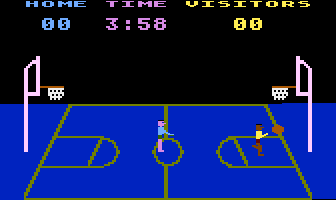 DP:
Were there any
unfinished games that you were working on when you left Atari?
DP:
Were there any
unfinished games that you were working on when you left Atari?
Alan Miller: No. David, Larry, and I worked on the 400/800 OS from about September 1978 to April 1979. I then completed Basketball for the 400/800 and left the company. I didnít work on any VCS carts during my last year at Atari.
DP: Do you have any prototype games in your personal collection?
Alan Miller: No. However, at Activision, I had programmed an Othello/Reversi game that was never published.
DP: Do you think that if Nolan Bushnell did not sell the company to Warner Bros., that things might have turned out differently?
Alan Miller: Yes, definitely, but itís impossible to say how it would have turned out. Atari might have been able to grow without a major capital infusion, but thatís difficult to be sure of. Warner put a lot of money into the company, which certainly helped pay for marketing and manufacturing the games and computers.
Sadly, tough, the management that was brought in to replace Nolan was totally inexperienced at consumer electronics, particularly video games, and that inexperience eventually killed the company. Itís particularly sad to see the vitality of todayís multi-billion dollar video game business and realize that the dominant players of the 70s and 80s, Atari and Mattel, who really pioneered the business, are no longer participants.
DP: Who originally came up with the idea to leave Atari and form Activision?
Alan Miller:
As we were finishing the OS for the 400/800 in early 1979, I decided that
I wanted to receive credit for my game design work and some form of royalty
compensation. I researched the compensation aspects of the recording industry
and the book industry, drafted a contract that woul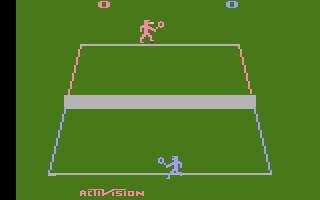 d allow me to be credited for
my work and receive a very modest royalty, and presented it to Atari
management. After a while, I told my three closest associates at Atari Ė David
Crane, Bob Whitehead, and Larry Kaplan Ė what I was doing. They joined me in
those discussions. We developed a growing impression that Atari was going to
agree to some plan along the lines we proposed. We were surprised in mid-year,
and our boss was also surprised, when senior management told us they would make
no changes. At that time, Atariís pay for engineers was on the low side,
generally slightly behind industry average. Whenever we hired a new engineer,
they tended to receive a salary higher than the current employees, which was
irritating. At that time, David, Bob, Larry, and I accounted for about
two-thirds of Atari cart sales, despite the fact that David, Larry, and I had
been exclusively working on the computer for many months.
d allow me to be credited for
my work and receive a very modest royalty, and presented it to Atari
management. After a while, I told my three closest associates at Atari Ė David
Crane, Bob Whitehead, and Larry Kaplan Ė what I was doing. They joined me in
those discussions. We developed a growing impression that Atari was going to
agree to some plan along the lines we proposed. We were surprised in mid-year,
and our boss was also surprised, when senior management told us they would make
no changes. At that time, Atariís pay for engineers was on the low side,
generally slightly behind industry average. Whenever we hired a new engineer,
they tended to receive a salary higher than the current employees, which was
irritating. At that time, David, Bob, Larry, and I accounted for about
two-thirds of Atari cart sales, despite the fact that David, Larry, and I had
been exclusively working on the computer for many months.
After Atari decided they werenít going to give us credit for our work or pay royalties, I talked with a great engineer who had just left Atari to start his own company, Joe Decuir, and asked for the name of the law firm he had used. He directed me to Wilson, Sonsini, Goodrich, and Rosati Ė now an extremely well-known firm in Silicon Valley. I made an appointment for the four of us to discuss incorporating our company and raising investment capital.
After meeting with the four of us, the attorneys began that process. In the first meeting they frankly told us that in order to attract venture capital, we would need to have an experienced management person on board. After a few weeks, they put us in touch with Jim Levy, with whom we developed a good working relationship. Larry decided at some point to cease participating, so Jim, David, Bob, and I continued our efforts to raise capital and were ultimately successful. Larry did later rejoin us, several months after we started Activision.
DP: What was the main reason for the exodus? Did it shake things up?
Alan Miller: I think the main reason for us leaving Atari was that within a year of Warnerís purchase of Atari, senior management had entirely changed over to new people who didnít understand our business, nor did they seem to even respect it. They didnít have any understanding of the technology underlying the business or the creative aspects of making interactive games.
Our desire to receive credit for our work and obtaining greater compensation was the tip of the iceberg of fundamental discontent with the senior management and the direction they were leading the company.
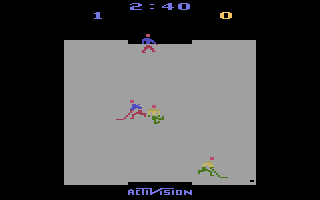 DP:
Werenít you guys
worried about the uncertainties of starting a whole new company?
DP:
Werenít you guys
worried about the uncertainties of starting a whole new company?
Alan Miller: Even though I was absolutely convinced the interactive game industry had a great future, I was worried about our chances of success. We only received a $650,000 commitment from our investors, Sutter Hill Ventures. They also required a substantial personal financial commitment from each of us, in the form of a cash investment in the company and that we take a cut in pay. I had to take out a second mortgage on my condo to make an investment. Had the company been unsuccessful, it would have been a significant financial blow.
DP: How did the brass at Atari take the news when you dropped the bomb on them? Tell us about that day.
Alan Miller: It didnít happen like that. There was no bomb. There wasnít even a murmur. We made no announcement that we were leaving to start a competitor. We didnít even leave together. As I remember, Larry Kaplan quit several weeks before the rest of us did. I think David and I quit about the same time. And I think Bob quit a few weeks later. Our departure wasnít that unusual. Several of Atariís best engineers had left or were leaving. Joe Decuir, whom I though was the single most valuable person at Atari, had left without any fanfare whatsoever.
Remember that Atari senior management fundamentally didnít understand the business. They didnít seem to know much about or care about the engineer group. I can remember that during our negotiations my bossí boss told me that he could hire several engineers ďoff the streetĒ who could do what I did for the amount of money I was asking for. He was essentially clueless about the intricacies of programming the VCS and the creative challenges of designing good games. There was no recognition of the fact that despite Atariís three year effort to build up a capable in-house game design group, very few of the people they hired were ultimately successful at creating and implementing popular games.
DP: Were there any repercussions legal or otherwise from Atari?
Alan Miller: Yes, after we started Activision, they sued us three times, every six months, both personally and as a corporation. Their total damage claim as I recall eventually stood at $26 million. It was sheer harassment. There was no basis for their claims and it was eventually settled for nothing. Activision was funded by one of Silicon Valleyís most prominent and experienced venture capital companies. In starting the company, we did everything perfectly properly, under the strict guidance of our attorneys and investors.
DP: Have you ever granted an interview for any other fanzines?
Alan Miller: Iíve done hundreds of interviews with games magazines and other publications over the last 25 years and dozens of video interviews. I canít recall giving an interview specifically to a video game fanzine, but itís entirely possible. When I talk with a writer, I donít pay much attention to what publication theyíre writing for. I just try to answer their questions. Sorry that I canít be more definitive on this point
DP: You were one of the interviewees on the Stella at 20 documentary that took place at Nolan Bushnellís estate. What was it like to be reunited with your former co-workers?
Alan Miller: I enjoyed it. We were a bunch of hard-working and talented engineers who helped change the world.
DP: I see from the documentary that you play a mean game of Kaboom. What tips can you offer us mere mortals?
Alan Miller: Go with the force, Luke. Donít look at the bombs Ė look through the screen. Allow your instincts to guide your hands. Donít think.
DP:
Have you ever
hidden any Easter eggs inside your games? If so, which ones and how do you get
at them?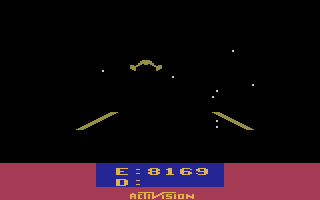
Alan Miller: No. At Atari, I followed company policy about putting no hidden features or personal mention in the games. At Activision, we were given credit on the box, manual, and cart, which was all I wanted.
DP: One of my personal favorites is Starmaster, which is a great adaptation of a computer classic. How long did it take you to complete?
Alan Miller: Probably 4-5 months. Starmaster was similar in concept to Star Raiders, which Doug Neubauer programmed for the 400/800. Doug was a chip designer who worked on the custom LSI chips inside the 400/800. After his chip design work was completed, he created this wonderful game for the computer. I sought to replicate that feeling of flying through space on the much more limited VCS.
DP: I play a lot of Robot Tank also. Once I managed to score a total of 81 tanks destroyed. I was curious as to what was the maximum in this game?
 Alan Miller:
I canít
exactly remember. Itís been a long time. But that sounds like a very high
score.
Alan Miller:
I canít
exactly remember. Itís been a long time. But that sounds like a very high
score.
DP: Who came up with the idea to award merit badges for high scores?
Alan Miller: It was probably Jim Levy. He was a brilliant marketing guy. Most of the Activision games awarded some patch or certificate for achieving certain score levels. We wanted to encourage players to develop a relationship with the company. It started with our first game, David Craneís Dragster. I still have the first certificate ever awarded for that game. Eventually we were receiving over 10,000 letters a week from fans and we had about 25 employees whose sole job was to respond to fan mail and phone calls.
DP: Honestly, do you ever tire of signing autographs?
Alan Miller: No, but Iím hardly ever asked to do so, except at the Classic Gaming Expo.
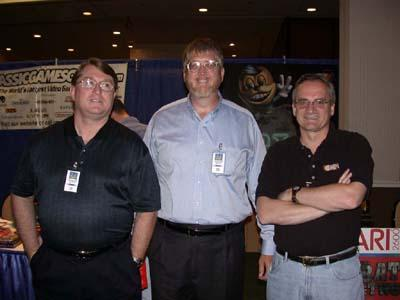
Alan Miller, David Crane, and Garry Kitchen at CGE 2K1
DP: Are you surprised or not at the attention that classic video games are getting?
Alan Miller: I was a little surprised at first. But after thinking about it, itís not much different from the attention given to early movies, television shows, records, and other forms of entertainment. The games were an enjoyable part of peopleís lives. Iím proud of the work we did at Atari and Activision. We worked hard to pack a lot of fun into those tiny carts. But I only spent about 7 years of my 25 years in the business at those two companies. Iím equally proud of the entertainment software I was later associated with at Accolade and Click Health.
DP: Was there any interaction amongst rival companies? Do Atari and Mattel people still feud or have they buried the hatchet?
Alan Miller: I donít think thereís any ongoing feud. At Activision, we developed games for both of those systems, as well as others. It turns out independent publishers have to put their successful games on as many systems as is possible, in order to maximize revenue from the games. Except for the hardware manufacturers, game publishers are all pretty much hardware agnostic.
Additionally, itís actually a pretty small industry and many of us have worked together in the past, which I think minimizes feuding. Larry Probst, Chairman of Electronic Arts, came out of Activision, as did Greg Fischback, Jim Scoroposki, and Rob Holmes, who started Acclaim. Don Mattrick, President of EA Studios, developed several games for us at Accolade. Also at Accolade we did North American distribution for Bruno Bonnelís Infogrames for several years, which eventually purchased Accolade. Scott Orrís first company, Gamestar, was acquired by Activision. Scott went on to be a very successful sports producer at EA. I have a lot of respect for these individuals, who have all been very successful.
DP: What do you think was the major factor in the collapse of the video game market in í84?
Alan Miller: I think there were two important factors. First of all, itís natural for the video game business to have its ups and downs. It has proven to be a cyclical business. The oscillations are driven by the introduction of new, more capable hardware systems. Weíre in the fifth cycle since the introduction of the Atari VCS in 1977. This current cycle will peak in 2003 or 2004. The general length of each cycle is about 5 or 6 years.
The down period of 1984-1985 was particularly intense because neither of the dominant players - Atari or Mattel Ė had introduced a next-generation console that embodied sufficient improvements over its previous system to become successful. At Activision, we were waiting and waiting for Atari to introduce a great new machine. We had heard they were spending $100 million a year on R&D and we expected something truly great. We were extremely disappointed by their 1982 introduction of the 5200 system, because it was a poor re-work of the 400/800 system, which was originally designed in 1978-79. In order to have a relatively smooth transition to the next generation consoles, a new and much improved machine, like the 7800, should have been introduced in 1981 or 1982, to allow the installed base to grow and take up the slack in sales from the dying VCS and Intellivision systems.
I wasnít close to Mattel, but I knew that the most important people in Atariís engineering group had all left. Senior management didnít understand the importance of the contributions that had been made by Bob Brown, Director of the Microelectronics group, which included all software development, and Joe Decuir and Jay Minor, who did the systems design and custom chips for the VCS and 400/800 computers. Atariís only decent console after the VCS was the 7800 and it was designed by an outside contract group (GCC).
The second factor, in my opinion, was that Atari, the dominant player in the business and larger than everyone else combined, was publishing a lot of terrible-quality games and shoving it into the sales channel. Consumers were obviously disappointed in the quality of much of their work, particularly expensive major licenses such as E.T., Pac-Man, and Raiders of the Lost Ark. Too many junk cartridges were sitting at retail and prices dropped dramatically.

DP: Were you at Activision until the bitter end? What was it like behind the scenes at that time?
Alan Miller: No, after five years, Bob Whitehead and I left Activision in late 1984 to start another game publisher, Accolade. We fundamentally didnít like the direction that Activision was taking at that time.
At Accolade, I created one game for the Commodore 64, Law of the West, but after that entirely devoted myself to management. I initially served as Vice President of Product Development and then as Chairman and CEO.
DP: Was forming Accolade at that time another risky venture or born out of necessity?
Alan Miller: It didnít seem risky to me, but still, we couldnít attract any investment in the company. Remember this was in 1984, in the depths of the first down cycle in programmable games. So Bob and I entirely funded it ourselves. Our additional five years of experience at Activision had given us a much better insight into the market. We had extreme faith in the continued acceptance of personal computers. We were profitable after our first year of development and continued to grow and be profitable through my ten years there.
We were puzzled why Activision couldnít make a profit. They had tens of millions of dollars in the bank and a great reputation, but we watched them take 17 successive quarters of losses and burn through just about all their cash before making a change at the CEO level.
DP: Another company that you helped found was Click Health. This was an educational software company. Was this a big transition from producing only pure entertainment software?
Alan Miller: The marketing and distribution were entirely different, but implementation of the products was very similar. I got into this venture because I was convinced video games could be used to change peopleís behavior and improve their lives. I had noticed changes in my behavior after playing violent games. I had grown quite concerned about the negative impact that violent games might have on children.
Click Health created and sold enjoyable Nintendo carts and computer CD-ROM games that were designed to improve childrenís health care behaviors for diabetes and asthma. The concept of doing this was initially developed by Steve Brown and his company, Health Hero Network. I had met Steve several times and admired what he was trying to accomplish. In late 1997, Health Hero decided to go in a different direction and so Steve and I started Click Health to continue the health education effort. Our clinical trials proved that playing video games can change childrenís behavior.
DP: Did you have to have a number of educators on your staff?
Alan Miller: Click Health was another company that couldnít attract investment, so we operated on a shoestring. Debra Lieberman, Ph. D., was our VP of Research. She was very experienced in the use of interactive technology for health education. The games were developed in conjunction with leading psychologists and medical experts Ė many from Sanford University.
The games were extremely successful in clinical trials. In a trial with Kaiser and Standford University diabetes patients, urgent care visits declined 77% for children who used our Nintendo cart, Packy & Marion, compared to a control group. Our anti-smoking game, Rex Ronan, was recognized by the Centers for Disease Control as an effective product and is an interactive exhibit in the Global Health Odyssey museum at CDC headquarters in Atlanta. Yet, despite the clinical successes, we could not make the company commercially successful. After four years of trying, I closed it in September 2001.
DP: What would you say is the video game accomplishment that you are most proud of?
Alan Miller: Iíd like to mention four of which Iím particularly proud. In chronological order, they are:
ē To have been a part of the team that developed the operating system for the Atari 400/800 computers.
ē To have co-founded Activision, the first independent video game publisher - a company committed to the highest quality interactive entertainment.
ē To have co-founded Accolade in 1984, in the depths of the first down cycle of programmable games and to watch it grow and prosper for ten years.
ē To have co-founded Click Health and be part of a pioneering effort to use video games to improve childrenís heath.
DP: Today you are a VP at Skyworks, which sells online games for company websites (Java language-based I assume?). How do you feel about commercializing your talent? Are you still involved in the coding aspects of video games?
Alan Miller: Itís a pleasure to be working again with David Crane and Garry Kitchen at Skyworks. Weíre creating games that appeal to just about all ages and genders, much like we tried to do in the early days. Our games are generally developed in Shockwave and are downloaded from websites and run in internet browser programs like Internet Explorer and Netscape Navigator.
Weíve been commercializing our talent for 25 years. I donít see this as being any different. Skyworksí games are fun and can be played for free. In exchange for receiving this free entertainment on our clientsí websites, consumers are exposed to commercial messages, much like broadcast television, but the advertisements are less blatant. Americans watch approximately $40 billion of television advertising each year. We feel the future for advertising supported interactive games is just as promising.
In answer to your last question, I havenít personally written a game since Law of the West, which was published in 1985. Since 1985, Iíve devoted myself to corporate management, marketing, and distribution issues. I donít delve too much into the technical implementation details. I rely on people who are skilled in those areas to do a great job.
DP: According to an interview that you did for Wall Street Journal (January 18, 1983): ďMr. Miller wasted about two months trying to come up with a three-dimensional game using red and green-lensed glasses. ĎIt didnít work this time,í he says, Ďbut I donít regret doing it. Trying something new makes it fun. And we all push ourselves to the limit each time out.íĒ What was the 3-D game that you were working on at Activision? Why did this project get scrapped?
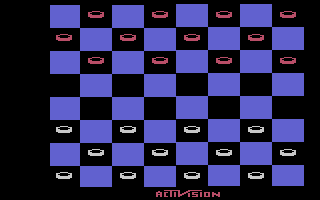
Alan Miller: The game was Checkers, my first Activision game, which was published in early 1980 without the 3-D display. It just didnít work well enough on the 2600.
As I recall, there were two main problems with using the red/blue glasses (anaglyph) on the 2600. The first is that the 2600 is only capable of 160 pixels of horizontal resolution. This didnít allow much precision in the horizontal offsets between the left and right eyes needed to position in 3-D space.
Secondly, television sets of that era didnít consistently render the colors. So the blues and reds in the display wouldnít exactly match the blue and red eye filters. On many sets, this causes a serious ghosting problem, in which each eye would still see a ghost of the other eyeís image.
Iím still extremely interested in the use of 3-D display for interactive and passive entertainment. With todayís computer and CRT technology, it is now possible for that to happen, if the user can accept wearing ďshutterĒ glasses that momentarily alternatively block each eye. This needs to occur at a minimum rate of 70 or 80 times per second for the effect to be acceptable (in my opinion), which precludes it from happening on NTSC televisions.

Receiving some well-deserved Ďaccoladesí at the 2003 Game Developerís Conference, along with David Crane and Bob Whitehead
|
BIO |
Alan Miller is one of the countryís most experienced entertainment software executives. In his 25 year career in the interactive entertainment industry, Miller co-founded two leading game publishers, personally designed several million unit-selling games, and managed the development of over 100 original entertainment software titles for approximately 20 different video game and personal computer platforms.
He graduated from the University of California at Berkeley in 1973 with a Bachelorís degree in Electrical Engineering and Computer Science. After working in Silicon Valley for a few years, he responded to a ďhelp wantedĒ newspaper advertisement and joined Atari, Inc. as a game designer and senior programmer in February 1977. There he developed the Surround and Hangman cartridges for the Atari Video Computer System prior to its launch in the fall of 1977 and then he designed Hunt & Score (a.k.a. Concentration) and Basketball in 1978.
In September 1978, after the failure of the first operating system effort for Atariís already announced personal computer, Miller joined David Crane, Larry Kaplan, Gary Palmer, and Ian Shepard to co-author the operating system for the Atari 400/8001200 personal computers. His last game at Atari was the Basketball cartridge for the Atari 400/800 computers.
In 1979, Miller co-founded Activision, Inc. with David Crane, James Levy, and Robert Whitehead Ė the first independent video game publisher. Activision grew to achieve $160 million in annual revenues in four years, making it the fastest-growing venture capital-backed company in American history (at that time). Miller served as Activisionís first Vice President of Product Development and he also designed and developed a number of best-selling game titles, including Checkers, Tennis, Ice Hockey, Starmaster, and Robot Tank for the Atari VCS.
In 1984, Miller and Whitehead co-founded Accolade, Inc. - a leading entertainment software publisher for personal computers and game console systems. In 10 years at Accolade, Miller served initially as Vice President of Product Development and rose quickly to the position of Chairman and CEO. Miller personally designed only one game at Accolade, Law of the West for the Commodore 64, which was also ported to several other popular personal computers of that era. Under his leadership, Accolade developed many well-known video game brands, including Hardball, Test Drive, Jack Nicklaus Golf, and Star Control to name but a few.
In 1997, Miller co-founded Click Health, Inc. Ė a pioneering company in the use of interactive edutainment software to educate children about proper care for diabetes, asthma, and other conditions. As Chairman and CEO, Miller managed the development, sales, and marketing of video game cartridges and computer CD-ROM games for this unique application. Clinical trials conducted at Stanford University and Kaiser documented a 77% reduction in urgent care visits for children with diabetes after playing the companyís health education games.
In 2001, Miller joined Skyworks, Inc., which was co-founded by David Crane and Garry Kitchen, and serves as Vice President of Business Development. Skyworks is the leading developer of compelling video game content across multiple platforms including online, mobile, handheld video game consoles, CD-ROMs and kiosks.
| GAMEOLOGY |
| GAME | SYSTEM | COMPANY | STATUS |
| Surround | Atari VCS/2600 | Atari | released |
| Hunt & Score (aka A Game of Concentration) | Atari VCS/2600 | Atari | released |
| Hangman | Atari VCS/2600 | Atari | released |
| Basketball | Atari VCS/2600 | Atari | released |
| 400/800 OS | Atari 400/800 | Atari | released |
| Basketball | Atari 400/800 | Atari | released |
| 3-D Checkers | Atari VCS/2600 | Activision | unreleased |
| Checkers | Atari VCS/2600 | Activision | released |
| Othello (aka Reversi) | Atari VCS/2600 | Activision | unreleased |
| Tennis | Atari VCS/2600 | Activision | released |
| Ice Hockey | Atari VCS/2600 | Activision | released |
| Starmaster | Atari VCS/2600 | Activision | released |
| Robot Tank | Atari VCS/2600 | Activision | released |
| Law of the West | C-64 | Accolade | released |